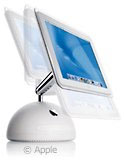What
happened to the simplification of Apple's computer lineup? Starting
in the late 90s, Apple trimmed its extensive computer lineup
(quick, ask your nearest non-computer nerd what the difference is
between a 7300 and a 7500!) and replaced their aging numeric
model naming scheme with a simpler one - iMac, Power Mac, and
PowerBook.
They dropped the PowerBook
3400c, 1400c, and 2400c in favor of the PowerBook G3 Series, which was
available in various CPU speeds and size screens. They dropped the
various Power Mac 7x00, 8x00, and 9x00 models, replacing them with
the PowerMac G3. And they
introduced a new product for consumers - a long-needed replacement
for the old Performa line -
the iMac.
Then Apple started adding products, including various versions
of the iMac (different colors, and later the iMac DV, iMac DV+).
They also introduced the iBook
for students and consumers who wants to travel with their
computers. The eMac was
introduced for education.

 They also had the short-lived G4 Cube, the newer versions of the iMac with a G4 processor (left)
followed by the model with a G5
(right), and then the Mac mini
- for those who are switching from a PC or just want a low-cost
modular Mac.
They also had the short-lived G4 Cube, the newer versions of the iMac with a G4 processor (left)
followed by the model with a G5
(right), and then the Mac mini
- for those who are switching from a PC or just want a low-cost
modular Mac.
Within the past couple years, Apple has once again been
criticized of having too many products and too confusing of a
product line. The iMac is available at two different processor
speeds and in two screen sizes, and then there's the eMac (Combo
drive or SuperDrive), which is getting dated, and the iBook G4 (two
sizes, two speeds, Combo drive or SuperDrive).
Now they have several different PowerBook models - 12", 15", and
17" with a Combo drive or SuperDrive. To make it even easier,
they're all called PowerBook G4! (The conventional way to
distinguish models is by screen size and processor speed, so you
might talk about the 12" PowerBook
G4 at 1.33 GHz or 17" PowerBook
G4 at 1.67 GHz.)
If you think about it, Apple' has lots of customers to provide
interesting computers to. If no one wants to buy an Apple computer,
their sales are going to go down. They've got to keep up interest,
and one way to do that is by adding new products.
They've got people interested in the iMac, and it's become a
well-established brand. So have the PowerBook and Power Mac - the
G5s are basically a standard in music production and art
studios.
It's sort of like the car industry, where every company seems to
be launching new models after initially simplifying their product
line. Volvo dropped their confusing 2x0/7x0/8x0/9x0 lineup and
replaced it with the V70, S70, and S90 - only to add the S60, S40,
V40, V70, and now the XC90 SUV.
Mercedes tried to simplify their hopeless modeling scheme (put
these in order of size: 420SEL, 300SL, 300CE, 190D, 300E) with
something that someone might actually understand, so they added
letters to signify the size of the car (C, E, S) and put the size
of the engine after that (e.g. E320). Then they started adding
models - right now they've got the B, C, CLK, E, M, R, S, and SL!
The newest model in the series being the R, which is a sort of
crossover SUV/minivan type vehicle. Overall, the lineup makes sense
to someone who knows it well.
The idea is to familiarize someone (ideally new customers) with
the initial lineup. You hear about the new modeling scheme, and you
have a rough idea of what the Mercedes C-class, E-class, and
S-class are like. You get an idea that the Volvo S70 is (fairly
obviously) smaller than the S90.
Then they spring new models on you, and since you already have
an idea of the lineup, you can follow along. You know what the
C-class is like, so you figure the B-class would be one step down
from that - a bit smaller, with a smaller engine and fewer features
- and you'd be right.
That's what Apple's done. We know what an iMac is; we know what
a PowerBook is. If the iMac is a consumer computer and the
PowerBook is meant for the professional, then an iBook would
obviously be combining elements of both.
Consumers aren't beyond understanding that a 12" screen is
smaller than a 14" one. Apple's made the PowerBook lineup pretty
simple: the 12" low-end model contains the least powerful
processor, and the most powerful is available in the 17"
version.
It's easy to understand once you're used to it - and Apple is
relying on the world being at least somewhat familiar with their
lineup. After all, even the BBC announces when Apple introduces new
models, Volvo and Mercedes could only hope to get that kind of
coverage.


 They also had the short-lived
They also had the short-lived 
